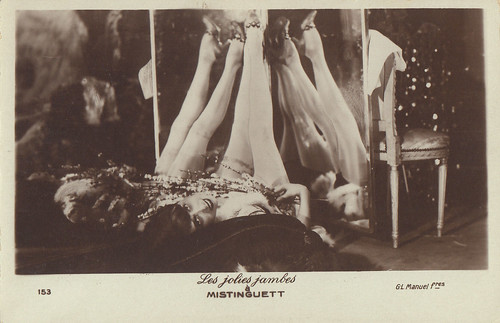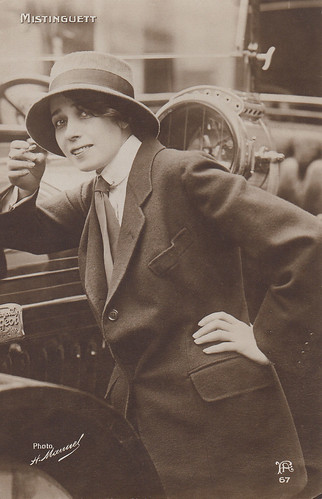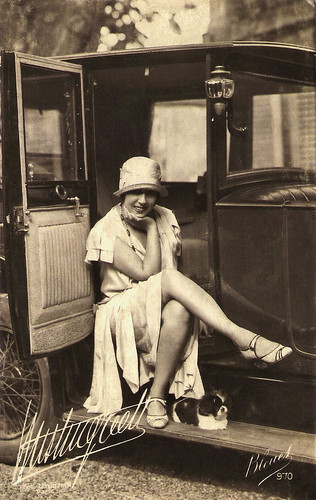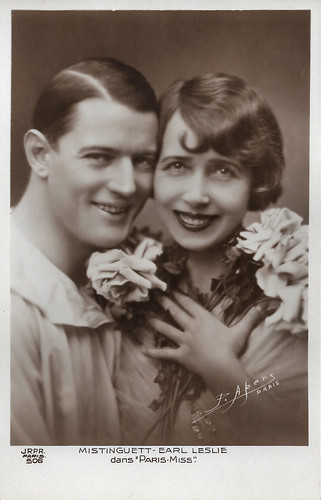Mistinguett (1875-1956) was a legendary French actress. As a singer, she captivated Paris with her risque routines. She became the most popular French entertainer of her time and the highest-paid female entertainer in the world. Mistinguett also appeared more than 60 times in the cinema.

French postcard, no. 153. Photo: G.L. Manuel Frères. Caption: 'Les jolies jambes à Mistinguett' ('Mistinguett’s pretty legs'). Collection: Marlene Pilaete.

French postcard, sent by mail in 1905.

French postcard in the series Nos artistes dans leur loge, no. 2. Photo: Comoedia.

French postcard by Cinémagazine-Edition, Paris, no. 175. Photo: P. Apers.

French postcard by Cinémagazine-Edition, no. 176. Photo: P. Apers.

Austrian postcard by Iris-Verlag, no. 5108. Photo: P. Apers.

French postcard. Illustration: Cabrol. Collection: Marlène Pilaete.

French postcard by Pro-Artis Gendre Editeur-diffuseur, Paris, no. 20. Photo: Walery / Bibliothèque Nationale.
Miss Tinguette
Mistinguett was born as Jeanne Florentine Bourgeois in Enghien-les-Bains, France, in 1875. She was the daughter of labourer Antoine Bourgeois and seamstress Jeannette Debrée. At an early age, Jeanne aspired to be an entertainer. She began as a flower seller in a restaurant in her hometown, singing popular ballads as she sold her flowers.
When a song-writing acquaintance made up the name Miss Tinguette, Jeanne liked it. She made it her own by joining it together and eventually dropping the second S and the final E (Mistinguett). Mistinguett debuted at the Casino de Paris in 1895 and appeared in shows at the Folies Bergère, Moulin Rouge, and Eldorado.
In 1908 she made her film debut in the short silent film L'empreinte ou La main rouge/The Impression or the Red Hand (Henri Burguet, 1908) for Pathé Fréres. Her co-star in this film was Max Dearly. The next year, he chose her to be his partner to create 'La valse chaloupée' (or the Apache Dance) in the Moulin Rouge. It became a worldwide sensation.
Between 1909 and 1915, she appeared on the stages of the Paris music halls but also in dozens of short films for Pathé, including Fleur de pavé/Her Dramatic Career (Albert Capellani, Michel Carré, 1909) with Charles Prince, Une petite femme bien douce/A Sweet Little Lady (George Denola, 1910) which she also wrote, and Le clown et le pacha/The Clown and the Pasha (Georges Monca, 1911), again with Prince.
In Une bougie récalcitrante/A Stubborn Spark Plug (Georges Monca, 1912), she appeared for the first time opposite the much younger Maurice Chevalier. With Chevalier, she would have a relationship of more than 10 years. The most successful film among her Pathé films was Les misérables (Albert Capellani, 1913), a four-part serial based on the famous novel by Victor Hugo.

French postcard by J.D. & Cie, Paris, series 20. Photo: DuGuy. Caption: Mistinguette, Eldorado. Sent by mail in 1904.

French postcard by MvB, no. 1977. Caption: Mistinguette, Eldorado.

Austrian postcard by Iris-Verlag, no. 5108. Photo: P. Apers.

French postcard by F.C. & Cie, no. 283. Photo: Boyer & Bert. Mistinguett and Max Dearly performing the Apache Dance. Collection: Didier Hanson.

French postcard by Etablissements photographiques de Boulogne-sur-Seine. Photo: H. Manuel. Mistinguett and Max Dearly at the Casino de Paris.

French collectors card by Pathé Frères, 1911. Mistinguett in the early French comedy Léocadie veut se faire mannequin (SCAGL/ Pathé Frères, 1911).

Spanish collector card (minicard) by Reclam Films, card, no. 4. Photo: Pathé Frères. Mistinguett in La Glu (Albert Capellani, 1913), presented in Spain as La Sirena. Her co-actors were Paul Capellani, Henri Collen (here on the left), Cécile Guyon, and Henri Krauss.

French postcard in the Nos Artistes dans leur loge series no. 55. Photo: Comoedia, Paris.

French postcard, no. 159. Photo: P. Apers, Paris.

French postcard by JRPR, Paris, no. 508. Photo: P. Apers. Mistinguett in the revue 'Paris Miss' at the Casino de Paris in 1930.
Legs of 500,000 francs
During the First World War, Mistinguett continued to appear in Pathé productions like the comedies La valse renversante/The Amazing Waltz (Georges Monca, 1914) again opposite Maurice Chevalier, and Rigadin et la jolie manucure/Rigadin and the Pretty Manicurist (Georges Monca, 1915) with Charles Prince.
In Italy, she appeared in La doppia ferita/The Double Injury (Augusto Genina, 1915). Opposite the legendary Harry Baur, she starred in Chignon d'or/The Gold Chignon (André Hugon, 1916) and Fleur de Paris/Flower of Paris (André Hugon, 1916). Mistinguett first recorded her signature song 'Mon Homme' in 1916. It was popularised under its English title 'My Man' by Fanny Brice and has become a standard in the repertoire of numerous pop and jazz singers.
In 1918, she succeeded Gaby Deslys at the Casino de Paris, and remained the undisputed star of nocturnal Paris until 1925. In 1919 her legs were insured for the then astounding amount of 500,000 francs. During a tour of the United States, she was asked by Time magazine to explain her popularity. Her answer was: "It is a kind of magnetism. I say 'Come closer' and draw them to me."
After WWI, Mistinguett's film career halted. She only appeared in a few more films, including L'île d'amour/Island of Love (Berthe Dagmar, Jean Durand, 1928) and Rigolboche (Christian-Jaque, 1936). Mistinguett's stage career prospered and lasted over fifty years.
Her last film appearance was as herself in the Italian musical Carosello del varietà/Variety Carousel (Aldo Bonaldi, Aldo Quinti, 1955). In 1956, Mistinguett died at the age of 80. She is buried in the Cimetiere Enghien-les-Bains, Île-de-France, France.

French postcard by Agence Phot. de reportage Keystone, Paris. Courbevoie: Mlle Mistinguett at the departure of the match Paris-London on hydrocycle by René Savard (crossing The Channel between Calais and Dover).

French postcard for Cherry Brandy "Regals". Illustration: Dolly Tree. Collection: Marlène Pilaete.

French postcard in the Les Vedettes de Cinéma series by A.N., Paris, no. 97. Photo: Sarony. Bouboule was Mistinguett's goddaughter, an admittedly talented child actress. She was born in 1917 and from 1921 on, she appeared in 13 films.

French postcard, no. 67. Photo: H. Manuel. Collection: Marlene Pilaete.

French postcard by Bleuet, no. 970. Photo: Utudjian, Paris.

French postcard by Bleuet, no. 971. Photo: Utudjian, Paris.

French postcard by J.R.P.R., Paris, no. 506. Photo: P. Apers. Mistinguett and Earl Leslie in the revue ' Paris Miss' at the Casino de Paris in 1930.

French autograph card.

French postcard, no. 113. Photo: Studio Harcourt.

French postcard by Editions P.I., no. 49. Photo: Studio Piaz.

French or Belgian postcard. Mistinguett in the sound film Rigolboche (Christian-Jaque, 1936).
Sources: Wikipedia and IMDb.
6 comments:
How wonderful to see these photos. For years I have seen the famous Mistinguett posters at various galleries, and knew nothing about her. Did not know Fanny Brice adapted My Man from her. Fascinating. Happy PFF!
I always wondered where her name came from. Like Linda, I've seen her posters and in fact I think I have a postcard of the poster.
What a beautiful woman, never gave thought to anything than old hollywood. Thanks for sharing this posting , will come and visit your stars of the past.
the hat in that first postcard would be the envy even of lady gaga! fascinating post as ever - happy PFF!
I love the musicals... what a career she had. Thanks for Sharing... Happy PFF
I love the expressions she gets on her face! She must have really been a *hoot and a holler* as my Granny would have said!!!!
Post a Comment